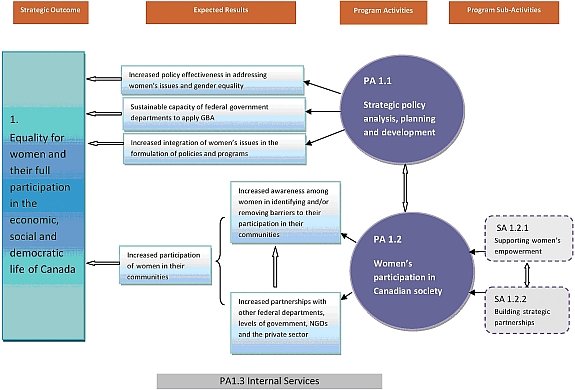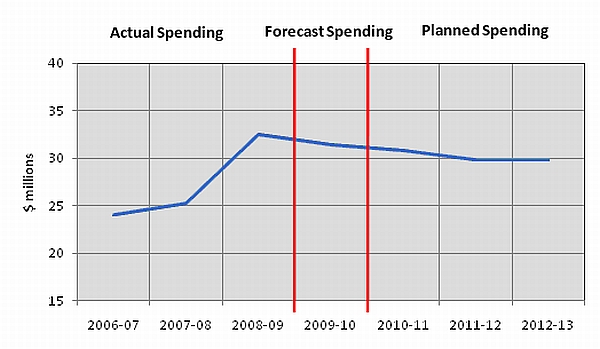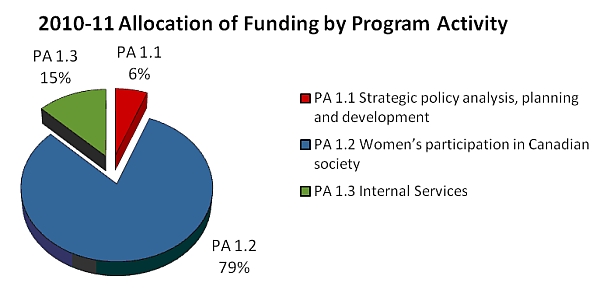Common menu bar links
Breadcrumb Trail
ARCHIVED - Status of Women Canada
 This page has been archived.
This page has been archived.
Archived Content
Information identified as archived on the Web is for reference, research or recordkeeping purposes. It has not been altered or updated after the date of archiving. Web pages that are archived on the Web are not subject to the Government of Canada Web Standards. As per the Communications Policy of the Government of Canada, you can request alternate formats on the "Contact Us" page.
Minister's Message
 As Minister of State (Status of Women), I am pleased to present Status of Women Canada's
Report on Plans and Priorities, 2010–2011.
As Minister of State (Status of Women), I am pleased to present Status of Women Canada's
Report on Plans and Priorities, 2010–2011.
In Canada, we have made commendable progress in advancing the status of women. In fact, last fall, Statistics Canada reported that in the first six months of 2009, women outnumbered men in the workforce for the first time at 50.9 per cent. Women are participating in our labour force and in our small-and-medium enterprises in record numbers and their contribution to Canada's bottom line is significant and still growing.
While we are proud of our achievements, the Government of Canada remains committed to closing the gender equality gaps in our society and to addressing the unique challenges women face, particularly those in marginalized situations. To this end, Status of Women Canada will continue to play a crucial role in advancing the Government's agenda for gender equality.
In 2010–2011, Status of Women Canada will continue to focus its efforts on three key areas: promoting women's economic security and prosperity; ending violence against women and girls; and encouraging women to assume leadership and decision-making roles. The agency will invest in innovative projects designed to empower women with the information, knowledge, skills and tools they need to assume leadership roles in Canadian public and private institutions. We will continue to work with partners in the public, private and non-profit sectors to advance women's economic security and prosperity. We also expect to achieve demonstrable results from the partnership projects launched in previous years.
We will continue to enhance the practice of gender-based analysis across all departments and agencies. To this end, a Gender-based Analysis Action Plan was tabled with the House of Commons Public Accounts Committee, thereby reinforcing the Government's commitment to promote this practice across its institutions.
The Government of Canada welcomes the recent initiative of the United Nations Secretary-General to prevent and eliminate violence against women and girls. Our support to the ground-breaking initiative, Uniting to End Violence against Women, further demonstrates our continued commitment to end all forms of violence against women. Violence against women remains a primary concern to Canadians and their government. Aboriginal women are among the most disadvantaged and vulnerable members of our society and we will continue to work with Aboriginal organizations and our partners to ensure the safety and security of all Aboriginal women.
I recently reported to the United Nations the progress Canada has made since 1995 in implementing the Beijing Platform for Action on the status of women. Our government will continue to work with our international partners to overcome the challenges to gender equality across the world.
In partnership with public, private and non-profit sector organizations, Status of Women Canada is prepared to support the Government in advancing equality for women and their full participation in the economic, social and democratic life of Canada.
The Honourable Helena Guergis, P.C., M.P.
Section I – Agency Overview
1.1 Summary Information
Raison d'être and responsibilities
| In 1976, the Government of Canada established the Office of the Coordinator, Status of Women, with the mandate to coordinate policy with respect to the status of women and to administer related programs. The mandate of Status of Women Canada flows from policy authority, Order in Council 1976-779. |
In fulfilling its mandate, Status of Women Canada (SWC) plays a key role in supporting the Government of Canada's agenda for equality for women and their full participation in the economic, social and democratic life of Canada. To play this role effectively, SWC works with partners such as federal departments and agencies, provincial/territorial governments, private sector institutions and non-governmental organizations. The agency also works in collaboration with other players to help fulfill Canada's domestic and international obligations relating to equality for women.
The agency carries out two Program Activities designed to achieve concrete results. The first result is demonstrated through inclusive and effective policies that advance gender equality and address issues that affect women. This result is made possible through enhanced capacity of federal departments/agencies in integrating gender-based analysis (GBA) in their legislative proposals, policies, programs and initiatives. SWC also seeks to achieve results that are demonstrated by women who are equipped with information, knowledge, skills and tools to identify and address barriers that impede their full participation in society.
SWC's Governance structure shows that the Executive Committee is accountable for the efficient management of the agency, achievement of its expected results and continued progress toward the strategic outcome. The Executive Committee is supported by other teams that play advisory and operational roles.
The SWC head office is located in the National Capital Region.
Regional offices are located in Montréal (serving Quebec and Nunavut), Moncton
(serving New Brunswick, Prince Edward Island, Nova Scotia and Newfoundland and Labrador),
Edmonton (serving Alberta, Manitoba, Saskatchewan, British Columbia, the Northwest Territories and Yukon)
and Ottawa (serving Ontario and national organizations) (http://www.swc-cfc.gc.ca).
1.2 Strategic Outcome and Program Activity Architecture (PAA)
In fulfilling its mandate, SWC seeks to achieve an enduring outcome for Canadians: equality for women and their full participation in the economic, social and democratic life of Canada. To assess progress toward this strategic outcome, SWC uses performance indicators that demonstrate the representation of women in the labour market, the representation of women in senior decision-making positions in the private and public sectors and women's participation in political institutions.
In compliance with the Management, Resources and Results Structures (MRRS) Policy, SWC's
Program Activity Architecture (PAA) which is displayed below shows the agency's strategic outcome,
expected results, Program Activities and sub-activities.
The PAA is the basic structure through which SWC carries out its two Program Activities,
allocates and manages resources, and on which it bases its reporting and accountability responsibilities,
including Estimates and Public Accounts.
In 2010–2011, SWC will start the process to examine its PAA to ensure that it is consistent
with the MRRS Policy.

[D]
1.3 Planning Summary
| 2010–2011 | 2011–2012 | 2012–2013 |
|---|---|---|
| 30.8 | 29.8 | 29.8 |
| 2010–2011 | 2011–2012 | 2012–2013 |
|---|---|---|
| 94 | 94 | 94 |
| Performance indicators | Targets | ||||
|---|---|---|---|---|---|
| 1% increase per year | ||||
| Program activity1 |
Fore- cast spend- ing 2009– 2010 | Planned spending |
Alignment to Government of Canada outcomes2 |
||
|
2010– 2011 |
2011– 2012 |
2012– 2013 |
|||
|
1.1 Strategic policy analysis, planning and development | 1.9 | 1.8 | 1.8 | 1.8 | Government affairs |
|
1.2 Women's participation in Canadian society | 26.2 | 25.1 | 24.1 | 24.1 | Economic affairs |
| 1.3 Internal services | 4.0 | 3.9 | 3.9 | 3.9 | |
|
Total planned spending (Note 1) | 30.8 | 29.8 | 29.8 | ||
| Note 1: In 2010–2011, the decrease of $1 million in planned spending from 2009–2010 reflects the conclusion of the five-year Sisters in Spirit initiative on March 31, 2010. Also, an amount of $2 million was approved for re-profiling in Grants and Contributions from 2008–2009 to 2009–2010 ($1 million) and to 2010–2011 ($1 million) to ensure continued funding for new multi-year partnership agreements with organizations across the country. | |||||
1.4 Contribution of Priorities to Strategic Outcome
| Operational priorities | Type | Links to strategic outcome | Description |
|---|---|---|---|
| Strengthen the implementation and use of GBA in the federal administration. | Ongoing | Equality for women and their full participation in the economic, social and democratic life of Canada | SWC, in collaboration with TBS and PCO, will continue to implement a GBA Action Plan to enhance the capacity of departments and agencies to integrate GBA in their legislative proposals, policies, programs and initiatives. At the same time, SWC will explore progressive integration of intersectionality. |
| Strategies to end violence against women and girls, including Aboriginal women and girls. | Ongoing | SWC will continue supporting initiatives designed to address violence against women and girls, including Aboriginal women and girls. | |
| Financial and professional assistance for projects to address women's economic security and encourage women in leadership roles | Ongoing | SWC will continue to invest strategically in projects, provide professional assistance to organizations and ensure accountability for results in order to provide women with opportunities to build their economic security and prosperity and to play active leadership roles. | |
| Management priorities | Type | Links to strategic outcome | Description |
|
Corporate Risk Profile | Previously committed | Equality for women and their full participation in the economic, social and democratic life of Canada |
SWC has identified three management priorities for 2010–2011.
These priorities represent opportunities for improvement in those areas identified through the
MAF Round VI assessment:
|
|
Values and Ethics | Previously committed | ||
| Audit and Evaluation | New | ||
1.5 Risk Analysis
Planning context
Canada remains among the world's stronger performers in advancing equality for women and men. In 2007, employment and participation rates for women aged 15 to 64 were the highest in the G7 and the sixth highest among OECD countries. In 2007, women earned 84 cents per hour for every dollar earned by men, up 2 per cent in five years. There is also a steady increase in women's representation in Canada's political institutions. At 29 per cent, our government has the highest representation of women in Cabinet than any government in the history of our nation.
The World Economic Forum's Global Gender Gap Index reported that Canada rose six spots in its annual global survey, moving ahead of the United States and leading the world in literacy rates, enrolment in primary and tertiary education, opportunity for professional and technical workers and economic participation. (http://www.weforum.org)
It is recognized, however, that gender equality gaps do remain in key areas and among certain groups of women in Canada. More women than men are involved in non-standard, precarious employment. This type of employment often provides no protection under labour codes or collective bargaining, offers little job security and presents limited opportunities for promotion.
The low participation of women in leadership and decision-making positions continues to limit Canada's standing in the area of gender equality. At 22 per cent, women's representation in Parliament is below the U.N.-recommended threshold of 30 per cent. Women remain under-represented in various occupational categories in Canada's private sector.
Violence against women and girls remains a major concern in Canada.
According to Statistics Canada, spousal violence represented 12 per cent of all violent crimes reported
to the police. Women continue to be the most likely victims, accounting for 83 per cent of victims
of spousal violence.3
Operating environment
Opportunities
In 1995, following the UN Fourth World Conference on Women, the Government of Canada committed to implementing GBA in departments and agencies. In 2009, the Office of the Auditor General (OAG) conducted an audit of selected departments and agencies4 to examine the extent to which this commitment is being implemented within the federal government. In May 2009, the OAG tabled its Spring Report, including the audit findings and recommendations on the application of GBA in federal institutions. The OAG recommendations include: clarifying GBA expectations, establishing an action plan, improving communications, analyzing GBA processes and documenting the challenge functions of central agencies.5 In response, SWC, in collaboration with the Privy Council Office and Treasury Board Secretariat, appeared before the Public Accounts Committee to table a joint Action Plan to implement the OAG recommendations. The implementation of the Action Plan represents an opportunity to create the capacity to apply or strengthen the application of GBA within federal organizations, thereby enabling departments and agencies to develop inclusive policies, programs and initiatives that respond to women's needs and advance gender equality.
Challenges
In 2008–2009, SWC participated in the Management Accountability Framework (MAF) Round VI assessment of departments and agencies. While SWC's performance in MAF Round VI was much improved, a number of areas were identified as opportunities for improvement, including: i) effective Corporate Risk Management, and ii) Values and Ethics.
SWC recognizes that the management challenges identified through the MAF assessment represent potential risks to its policy and program functions, can limit its ability to achieve the expected results and may affect progress toward its strategic outcome. As such, the agency is committed to enhancing its management capacity overall and to addressing the issues identified through the MAF assessment.
In 2010–2011, SWC will implement three management priorities, including areas identified through the MAF
Round VI assessment: i) a Corporate Risk Profile; ii) a Code of Conduct and iii) SWC's Audit
and Evaluation function will be strengthened and the summative evaluation of the Women's Program will be
completed.
1.6 Expenditure Profile
In 2010-2011, SWC plans to spend $30.8 million. In 2008–2009, spending was the highest because of the re-profiled funding and additional resources obtained through Budget 2007.
Spending trend
For the period 2006–2007 to 2009–2010, the total spending included all Parliamentary appropriations: Main Estimates, Supplementary Estimates and Treasury Board Vote 10, 15 and 23. It also included carry forward adjustments.
For the period 2010–2011 to 2011–2012, the total spending corresponds to the planned spending.
At this point, supplementary funding remains unknown, except for the funding to be transferred from the Department
of Canadian Heritage for the Office of the Minister of State (Status of Women).

[D]

[D]
The figure above displays SWC's funding by Program Activity for 2010–2011.
Most of SWC's funding is allocated to Program Activity 1.2: Women's participation in
Canadian society, which includes funding to organizations for eligible projects.
|
Vote # or Statutory Item (S) |
Truncated Vote or Statutory Wording |
2009–10 Main Estimates |
2010–11 Main Estimates |
|---|---|---|---|
| 85 | Operating expenditures | 8.6 | 9.7 |
| 90 | Grants and contributions | 19.9 | 19.9 |
| (S) | Contributions to employee benefit plans | 1.1 | 1.2 |
| (S) | Salary and motor car allowance for Minister of State (Status of Women) [Note 1] | — | 0.0 |
| TOTAL | 29.6 | 30.8 | |
| Note 1: The 2010–2011 motor car allowance for the Minister of State (Status of Women) equals $2,000. The difference between the two fiscal years can be attributed to the transfer of funding from the Department of Canadian Heritage for the Office of the Minister of State (Status of Women) and additional funding for collective agreements. | |||
